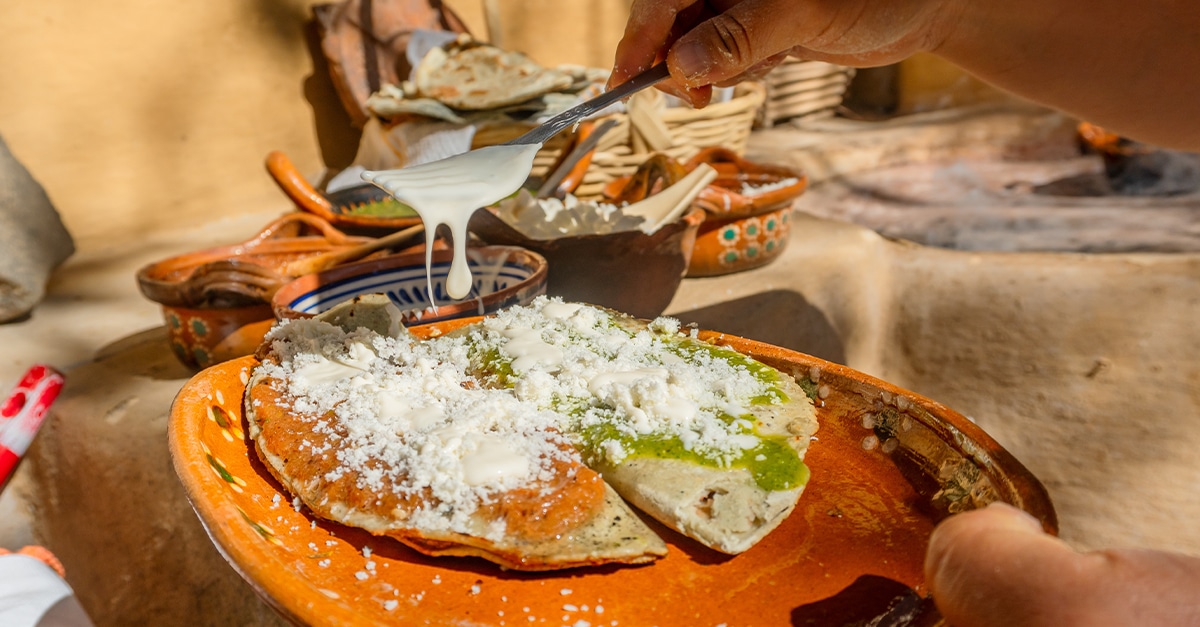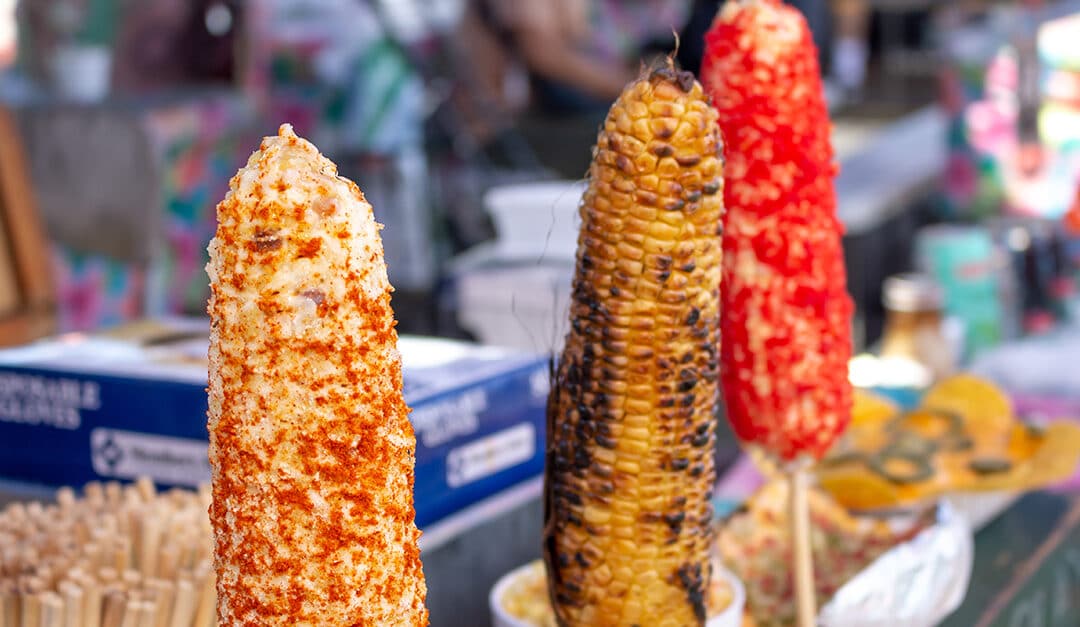Dinner time! Do you feel like eating outside today? Great, so do we! What are you and your family craving? Something sweet? Or maybe you prefer savory food. How about something spicy? Whatever it is, Mexico has it! There’s a great variety of street food there.
Do you know what’s the best? Eating delicious food is a fun way to get your kids excited about learning Spanish. First, because it’s a way to immerse them in the culture, and that goes hand in hand with language. Second, because it sparks curiosity to discover new dishes and flavors. Third, because it’s delicious!
So, check out our Mexican street food tour for you and your kids to start a tasteful journey while practicing Spanish.
Tacos
That’s right, one of Mexico’s most popular foods is part of their Mexican street food culture: We’re talking about tacos!
We’re not kidding when we say you’ll find many street tacos’ stalls all around Mexico. Seriously, there are tons of them! After all, they’re one of the most traditional foods in this country.
The best of all is that there are different types of tacos; that means different fillings. Here are some common ones:
- Tacos al pastor (“pastor” tacos, which involves pork meat)
- Tacos de suadero (brisket meat tacos)
- Tacos de tripa (cow chitterlings tacos)
- Tacos de lengua (tongue taco)
- Tacos de carnitas (pork meat tacos)
- Tacos de cochinita (“cochinita” tacos, which involve pork meat)
- Tacos de birria (marinated goat meat tacos)
- Tacos de cabeza (beef head tacos)
You’ll also notice that these stalls have some bowls with lemons, coriander, and onion. As well as different types of sauces, especially green sauce and red sauces.
These are often the ingredients that go with the tacos. The bowls are there so you can grab the ingredients inside each bowl and put them in your tacos to your liking.
Tacos de Canasta
Yes, these are other types of tacos. But we had to make them their own space on this blog to talk about them because they’re a bit different from other tacos. In fact, you won’t find these in the same street stalls as other tacos.
You’ll usually find people selling these tacos on a table on the street with a basket, inside which are the tacos! Or you’ll also find them with people in a bicycle that carries a huge basket with the tacos. That’s why they’re called “tacos de canasta”: “Canasta” = “basket”.
The difference with other tacos is the tortilla of the “tacos de canasta” is bathed or marinated in oil and a special sauce.
Some of the most common fillings are beans, smash potatoes, crackling, green mole… But, of course, there are more.
Barbacoa
Every now and then, you’ll see some street stalls of “barbacoa”. Which is sheep or lamb meat. But it can also be goat or beef meat.
You can find a “barbacoa” stall as the only stall in the streets. And you can also find them in some markets alongside more stalls for other kinds of foods.
You can choose to eat there, as the “barbacoa” stalls often have stools to sit and eat. You can ask for tacos of “barbacoa”. In the stalls there are usually bowls with coriander, onion, and sauce for you to add to your tacos.
They also sell “consomé de barbacoa” which is “barbacoa” broth. Besides the meat, it includes onion, coriander and chickpeas.
You can also choose to take the “barbacoa” to go. And they’ll always include you some tortillas, so you can make your tacos at home.
Elotes
Are you ready for one of the most delicious Mexican street foods? Then you have to try the “elotes”.
Around the streets of Mexico, you’ll find small street stalls selling “elote” (corncob). As well as “esquite”, “elote en vaso”, “trolelote”, “chascas”, “vasolote” (corn in a styrofoam cup). As you can see this one has many different names depending on the region of Mexico that you’re in.
Both “elotes” and “esquites” go with mayonnaise, grated cheese, lemon, salt, and chili powder. When they’re preparing it, they’ll ask you: “¿Chile del que pica o del que no pica?” (chili of the one that’s spicy or the one that’s not spicy?) Choose the one that you prefer.
Tamales
“Tamales” are one of Mexico’s most traditional dishes. They eat this for breakfast, dinner, birthdays, and festive days. So you can find tamales very easily in Mexico.
But what are they? They’re large pieces of corn dough with different flavors and fillings most commonly wrapped in corn husk or banana leaves. The most popular tamales flavors are:
- Tamal de dulce (sweet tamale)
- Tamal de rajas (chili strips tamale)
- Tamal verde (green sauce tamale)
- Tamal rojo (red sauce tamale)
- Tamal oaxaqueño (Oaxacan tamale)
- Tamal de elote (corn tamale)
- Tamal de frijol (beans tamale)
These are just a few. You’ll find places where they sell other flavors, like “tamales de camarón” (shrimp tamales) or “tamales de chocolate” (chocolate tamales).
Depending on the tamal you choose, you might notice there are some fillings within the dough, like chicken or cheese.
We can’t forget the “torta de tamal” or “guajolota”, a classic from Mexico City. It consists of putting the tamal in a “bolillo” (type of loaf). You can ask for a “guajolota” in the different tamales’ street stalls in Mexico City. If you prefer to prepare it at home, you can just ask for them to add the “bolillo” separately.

Garnachas
While in Mexico, you might hear your Mexican friend say: “Vamos por unas garnachas, ¿no?” (Let’s go for some ‘garnachas’, no?) Or: “Tengo antojo de unas garnachas” (I’m craving some ‘garnachas’)
But, what really are “garnachas”. This is a way to refer to all street food that’s made of dough and fried in oil or cooked in a “comal” (griddle). So, yes, there are a lot of “garnachas”, such as:
Quesadillas
It’s a tortilla folded over in half, inside which they put different ingredients, including cheese.
There are many different types or flavors of “quesadillas”. Like “quesadilla de rajas” (chili strips quesadilla), “quesadilla de papa” (smash potato quesadilla), “quesadilla de flor de calabaza” (squash blossom quesadilla), and many more.
There’s also the “quesadilla de queso” (cheese quesadilla), which only has cheese.
In Mexico City the “quesadillas” often go without cheese, so if you want them with cheese you have to specify that. But in other parts of Mexico when you ask for a quesadilla, they always have cheese along with the type of “quesadilla” you asked for.
So, for example: If you ask for a “quesadilla de rajas”, besides the chili strips, they’ll also add cheese.
The above has created a discussion between Mexicans. Some say that “quesadillas” must have cheese; it’s in the name: “Quesadilla” because of “queso” (cheese).
But some others say it doesn’t have to be that way, and they go without cheese. So you have to specify whenever you want a quesadilla with cheese.
Gorditas
This is thick fried corn dough in the form of a circle. It’s cut open on top to stuff it with the ingredient of your preference, like crackling, beans, ground meat, and more. They go with parsley, onion, grated cheese, and spicy sauce on top.
Sopes
“Sopes” are fried dough in the shape of circles with refried beans spread on them. On top of them goes some lettuce, grated cheese, cream, chicken, and a spicy sauce.
Huaraches
A “huarache” is a large corn dough in the shape of an oval that works as the base. There are some refried beans spread on the dough and some grated cheese, coriander, onion, and meat. Oh, and of course, we can’t forget the spicy sauce.
Tlacoyos
“Tlacoyos” fried corn dough in a large but small oval-like form; they’re not as large as a “huarache”. The dough is very thick, and it’s stuffed with different ingredients. You can choose your favorite one. There are “tlacoyos” of broad beans, “requesón” (a type of cheese), beans, and pressed pork rinds.
Then, on top of the “tlacoyo” – that is, along it – you have to add “nopales”, grated cheese, onion, coriander, and sauce.
Molotes
This is another dish made from fried corn dough in a large but fat shape similar to an oval form. Not like a full circle, but not fully flat either. You might also find them with a larger shape, more like a “quesadilla”.
The dough can be filled with different ingredients, like cheese, chicken, potatoes, and more.
They’re served with cream on top and sauce, and you can also add some grated cheese.
Memelas
Very similar to “sopes”, “memelas” are prepared with corn dough, but they have a large and oval shape. They’re cooked in a “comal” and spread with “asiento”, which comes from lard.
After the lard and once they’re cooked, they’re spread with refried beans. On top, they have cheese, and spicy sauce.
Chilaquiles
Although you might think of “chilaquiles” as a dish you find in restaurants or at home, you can also find it on some street stalls. Especially in the morning, because many Mexicans eat “chilaquiles” as a breakfast. You’ll see some people with a table on the street serving this dish in a Styrofoam container and selling them.
“Chilaquiles” are fried tortilla chips with sauce and cream, grated cheese, chicken or sometimes other types of meat or even fried eggs on top.
Tortas
“Tortas” are made of a “bolillo” or a “telera”, two different types of loafs of bread. You cut them so you have two sides of the bread and between both sides you add different things depending on which type of “torta” you want.
There are different types/flavors, like:
- Torta de jamón (ham)
- Torta de milanesa (type of meat)
- Torta de carnitas (mix of meat)
- Torta de salchicha (sausage)
- Torta cubana (“Cuban”, which has many different things)
These were just a few, you’ll find many more.
Turrón rosa
If you’re craving a dessert, you might like this. Lately, the “turrón rosa” has become more and more popular on social media.
It’s from Guadalajara, Jalisco. It’s made of sugar water, lemon, vanilla, and pink coloring. On top of it, they’ll add some lemon, “chamoy”, and chili powder.
The consistency is chewy.
Camote
A common sweet food you’ll see in the streets of Mexico is the “camote”. It’s a sweet potato that has sweetened condensed milk on top. But if you prefer, you can ask for it without the condensed milk.
But sweet potatoes are not the only thing they sell! If you prefer fried plantain, they also have that. And they also serve it with sweetened condensed milk on top.
You can find these in a “carrito de camotes” (‘camotes’ food stall on wheels) passing by different streets every now and then. When they’re around, they’ll make a very particular high pitch noise, so you’ll know someone is selling “camotes” nearby.
Because they’re not set in one determined spot, sometimes you’ll have to run after the small “camote” stall, so you don’t miss it.
TruFluency Kids Has the Perfect Recipe for Spanish Fluency
Are you ready to help your kids learn even more cultural and linguistic aspects of the Spanish language? Awesome, we’re ready to help you!
TruFluency Kids is an online Spanish immersion school with native teachers! This means your children will learn from people that know the language inside out. They not only know the most serious things, like grammar, but other fun stuff as well, like idioms.
We teach through fun activities, because we know children are full of energy and creativity. They’ll sing, dance, read, do crafts, play games, and even cook in Spanish!
This way we make sure the class environment is fully in their target language. We barely use English. This is a very natural way to acquire the language.
Plus, we encourage them to speak in Spanish in every single lesson! It’s the best way to achieve language fluency!


